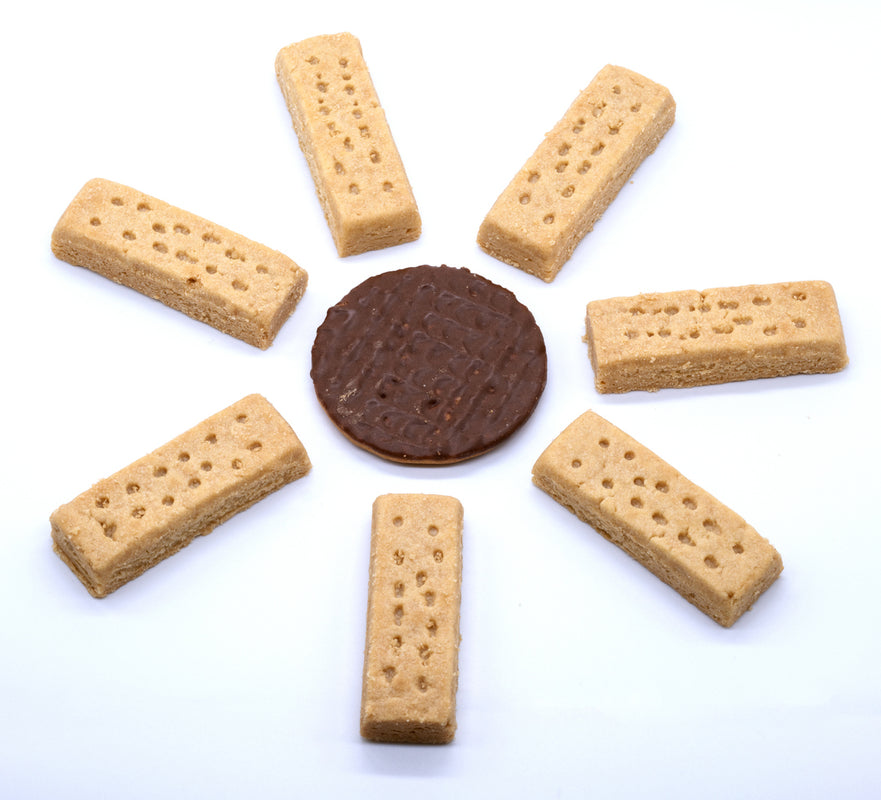For the British, shortbread has a profound cultural and sentimental significance. It represents a connection to history and heritage as a prized delicacy with centuries-old origins. Its presence at festive occasions like Christmas and Hogmanay strengthens its significance as a symbol of community and tradition. Additionally, the buttery richness and nostalgic allure of shortbread evoke a feeling of cosiness and familiarity while providing a taste of home and a reminder of special occasions. Its enduring appeal across generations confirms that it is more than just a cookie. In fact, it is a symbol of British cuisine that connects people to their shared history and culture.
The History of British Shortbread

Shortbread's origins can be traced to at least the 12th century when it was first known as biscuit bread—cookies made from leftover bread dough that were occasionally sweetened and baked until they turned into a tough, dry rusk. This practice existed in Scotland and throughout the entire British Isles.
As the leavening gradually disappeared and was replaced by butter, it became an expensive fancy treat that was only purchased for holidays like Christmas and Hogsmanay (the Scottish New Year).
Ingredients of Shortbread
Butter is an important ingredient in shortbread. The term ‘short’ refers to biscuits and pastries that are crumbly, as shortcrust pastry should be. Because of this, the fat used to make biscuits and pastries is referred to as shortening.
The allure of British shortbread lies in its simplicity, with just a handful of ingredients that work harmoniously to create a symphony of flavour and texture. Traditionally, shortbread calls for three basic ingredients: butter, sugar, and flour. While variations abound, these core components form the heart of this delicate treat, resulting in a cookie that's melt-in-the-mouth delicious.
Creating the Perfect Shortbread
The magic of British shortbread is both in the ingredients and the creation process. The foundation for the rich buttery flavoured cookie is achieved by creaming the butter with sugar until they are light and fluffy. The next process is to gradually add flour and mix till a soft dough is created. This dough is then gently pressed into a baking pan. The dough is scored to make individual portions and give the shortbread its distinctive appearance.
Variations and Texture of Shortbread

Although all love the classic shortbread recipe, inventive bakers have improvised this traditional treat with unique and impressive modifications. Vanilla extract, citrus zest, and even finely chopped nuts can be added to create new flavours. Additionally, the versatility of this beloved cookie is demonstrated by chocolate-dipped shortbread, jam sandwiches, or sea salt decorations.
Depending on the ingredients proportions and the baking time, shortbread can have a texture that ranges from delicate and crumbly to slightly more firm. For a more tender texture, recipes call for cornstarch or rice flour. Shortbread is available in a variety of shapes in addition to the well-known round petticoat tail shape, including fingers, squares, and even elaborate designs.
Some Iconic Places that Create the Most Deletable Shortbread
Walkers Shortbread is a renowned company making traditional shortbread since it was founded in Scotland in 1898. They use basic ingredients to make buttery, melt-in-your-mouth treats, the recipe for which is deeply rooted in tradition.
Deans Shortbread is another well-known Scottish brand that has been producing mouthwatering shortbread since the 1970s. To satisfy a variety of tastes, they offer both traditional shortbread and variations like chocolate chip and stem ginger.
Prestat was founded in 1902 and is best known for its opulent chocolates, but it also makes superb shortbread. Their shortbread offers a delightful balance of taste and textures with a hint of British elegance.
Shortbread House of Edinburg, Island Bakery Organics, The Shortbread Company, Brodies of Edinburg, Reids of Caithness, and a few more are known for their delicious shortbread.
Shortbread is Popular – Overseas

Shortbread has become popular outside of the UK. Its ease of preparation and deliciousness make it a universal treat that appeals to people of all cultures. Shortbread cookies are a seasonal favourite in both Canada and the US and are enjoyed along with other festive treats during festivals.
Shortbread During Festivities
The significance of shortbread goes beyond its taste. It serves as a sincere gesture and is frequently given as a sign of hospitality or shared with close friends and family members. Shortbread is used in numerous UK celebrations in addition to Christmas and Hogmanay.
These buttery treats are served at weddings as a sign of wealth and joy for the newlyweds.
Similarly, shortbread can be found on tables on Burns Night, a holiday honouring the Scottish poet Robert Burns, bringing a touch of tradition to the celebrations.
Shortbread remains a beloved companion at afternoon teas, garden parties, and family gatherings, fostering happy times and togetherness. The simplicity of this dish captures the spirit of British culture, which combines history, friendship, and the enjoyment of sharing the good things in life.
Regional Variations of Shortbread
Although shortbread undoubtedly has a Scottish connection, it is now widely consumed across the UK and beyond. The traditional recipe frequently gets a local twist in each region. For instance, oatmeal may be added to create heartier versions known as oatcakes in the Scottish Highlands.
A variation known as bannocks in the Shetland Islands contains caraway seeds for flavouring. There are numerous other regional shortbread variations in England.
Cornwall's rich culture and mining heritage are celebrated in saffron-infused shortbread.
In Wales, people love the Teisen Radell, which means griddle cake in Welsh. This is an example of how this popular treat adapts to reflect regional ingredients and culinary traditions. It has layers that resemble shortbread with a hint of spice.
Conclusion

Shortbread is a simple yet versatile treat that represents tradition and the joy of sharing. It continues to be a beloved representation of joy and comfort, whether it is eaten as a traditional recipe or a regional variation.


 Easter 2026
Easter 2026
 Frozen Food
Frozen Food
 Baking
Baking
 Beans, Peas, Soups & Tins
Beans, Peas, Soups & Tins
 Biscuits, Crackers & Cookies
Biscuits, Crackers & Cookies
 Candy / Sweets
Candy / Sweets
 Crisps & Snacks
Crisps & Snacks
 Chemist / Pharmacy
Chemist / Pharmacy
 Desserts
Desserts
 Gravy, Stock & Paste
Gravy, Stock & Paste
 Haggis
Haggis
 Indian Sauces, Paste and Pickle
Indian Sauces, Paste and Pickle
 Jams & Preserves
Jams & Preserves
 Poppy Appeal
Poppy Appeal
 Pot Noodles & Super Noodles
Pot Noodles & Super Noodles
 Scone Mix
Scone Mix
 Gluten-Free / Free From
Gluten-Free / Free From
 Tea Accessories
Tea Accessories
 Teapot & Tea sets
Teapot & Tea sets
 Tea For One
Tea For One
 Sugar & Creamer
Sugar & Creamer
 Tableware
Tableware
 Serveware
Serveware
 Plates & Trays
Plates & Trays
 Bowls
Bowls
 Cups & Saucers
Cups & Saucers
 Mugs
Mugs
 Silverware
Silverware
 Dinnerware - Accessories
Dinnerware - Accessories
 Dinnerware - For Pets
Dinnerware - For Pets
 Victoria Eggs - Hand-Drawn UK Homeware
Victoria Eggs - Hand-Drawn UK Homeware
 Jewelry & Accessories
Jewelry & Accessories
 Sale
Sale
 Christmas Gifts
Christmas Gifts

